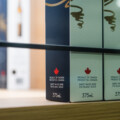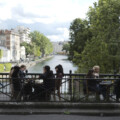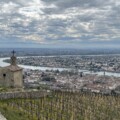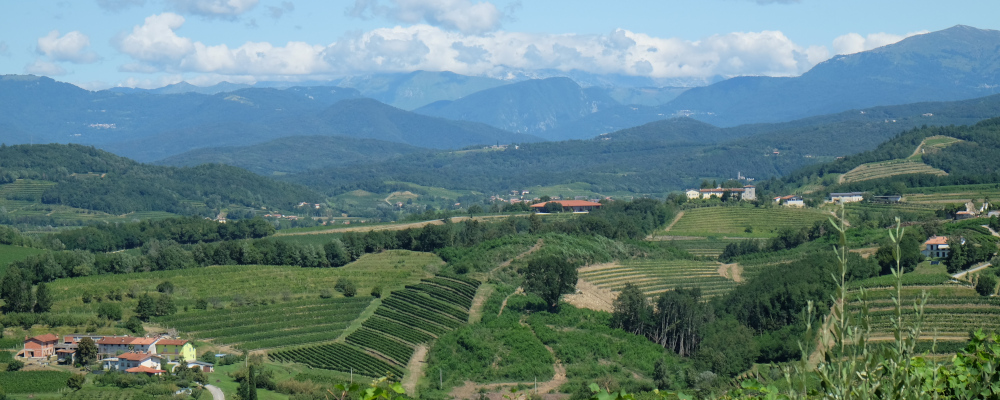Torgiano is a small town in Umbria more or less in between Perugia and Assisi, named for its crenelated medieval tower. It’s in the valley of the Tiber River; a picturesque country, with rolling hills, alternating between olive groves, woods, and vineyards.
This is where St. Francis built his hermitage, and between the sweep of history and natural beauty it feels like more than the physical centre of Italy, but maybe the metaphysical one too. Also, people there make good wine.
The Torgiano DOC is one of Italy’s smaller ones, and is a near “monopole,” dominated by the Lungarotti family and their namesake winery. It’s also dominated by the red wine Lungarotti makes from Sangiovese and Colorino, which they call, and have trademarked, “Rubesco,” the Latin verb “to blush.”
Giorgio Lungarotti named the Sangiovese-based wines he made in Umbria, Rubesco, to distinguish them from better known ones made in Tuscany. Lungarotti died in 1999, after a storied career. Like many of the post-war Italian wine revolutionaries, who came to prominence in the 1960s and 70s, Lungarotti began by organizing local growers into one brand, with a focus on consistency and quality.
The first vintage of Lungarotti Rubesco was 1962. I recently attended a virtual tasting of Lungarotti presided over by Giorgio Lungarotti’s daughter, Elena Severini. Severini is something of a legend herself, and is one of the original le donne del vino (the women of wine), beginning in the Lungarotti cellars before pivoting to exports during the heady days of the 1980s when Italian wines began to get serious attention in the wine world.
Before bringing a small group of Canadian wine journalists through a tasting of the wines below, Severini told us that when she began trying to market her family’s wines that “although Umbria is the green heart of Italy, its wines were not very well known, except for perhaps Orvieto.” If Lungarotti wines from Torgiano, or (later) Montefalco, were on a wine list outside of Italy, they were invariably found grouped in with the wines of other regions.
Wines from Umbria are still something of a novelty, though red wines made in the Montefalco DOCG appellation, made with the Sagrantino grape, have devoted following. (Montefalco got its DOC in 1979 in no small part due to the efforts of Giorgio Lungarotti, who had established a vineyard and winery there; and again in 1990 when it became Italy’s tenth DOCG.) One place Umbrian wines are widely drunk is in nearby Rome, where I have found them on wine lists advertised as “local,” and associate them with trips to the Eternal City.
Lungarotti wines are broadly available throughout Canada. The tasting I recount below was organized by Lungarotti’s Ontario importer, Profile Wine Group, so the pricing information, such as it is, is based on that province and may vary, though likely not by much.
Wines
Torre di Giano Vigna Il Pino Bianco di Torgiano DOC 2018
The first wine Teresa Severini guided us through was Lungarotti’s fancy white: Il Pino. It’s named for the umbrella pine tree that stands in the vineyard. Production began in the early 70s, and Lungarotti began ageing its whites in wood, as a nod to Burgundy. The original blend Umbrian native grapes, Grechetto and Trebbiano, has been recently augmented with Vermentino as an adaptation to global warming. Floral notes on the notes melt into honey tones over pear and citrus fruit. It’s elegant but fresh and food friendly, and when it’s available in this country would likely cost around $30-$40.
Rubesco Rosso di Torgiano 2019
Moving to red Signora Severini took us to the wine that started it all. Sangiovese-based reds from Umbria can sometimes be seen as a kind of extension of their more well known cousins from Tuscany. (Cortona is, for instance, is just 60 kilometres from Torgiano.) But the Rubesco is a different animal; although there is a strong cherry note, there is also a touch of graphite on the finish and a stoniness and freshness (belying a 14 percent alcohol by volume) to the wine, that makes it its own. Severini explains the wine sees some, mostly old, oak, but never for more than a year, and freshness and food compatibility was always foremost on Giorgio Lungarotti’s mind. It typically sells for $20-$25 a bottle.
Rubesco Riserva Vigna Monticchio Torgiano Rosso Riserva DOCG 2017
Lungarotti’s Riserva is made from 100 percent Sangiovese from a single vineyard. It sees a year in large oak casks followed by three years of ageing in bottle to, as Signora Severini put it, “maintain the integrity of the wine.” Marketing speak aside, the wine maintains both (again) a freshness and a deep, dark, complex symphony of black fruit and violet notes. When it can be found, it sells for about $70 a bottle.
San Giorgio Umbria IGT Rosso 2017
Giorgio Lungarotti was not, his daughter told us, immune from the trend in the 1970s and 80s in Italy of planting and making wine from the so-called “international varieties,” meaning French (or French by way of California) grapes like Chardonnay or Cabernet Sauvignon. While the conventional wine world wisdom is very much that “indigenous” grapes are the best suited to grow and be made into wine, wherever one might be, all those vines planted 40 or 50 years ago are making some pretty fantastic wines in their old age. Winos turn their noses up at them at their peril.
The San Giorgio is actually a 50 percent Cabernet Sauvignon and 50 percent Sangiovese blend. Accordingly and true to type it shows a dark red cherry character that’s supported by a line of blackcurrant notes. All of this comes back to the Rubesco wines with that curious graphite-mineral finish. The Cabernet lends a natural tannic structure, and I thought this five-year-old wine could do with a little more age. When it can be found it retails for around $50-$60 a bottle.
Montefalco Sagrantino DOCG 2018
Teresa Severini explained to us that Sagrantino in Umbria was, until the last quarter of the 20th century, grown exclusively to make passito; sweet dessert wine. As with Amarone in the Veneto, it was only with new technologies like temperature-controlled fermentation could the winemakers in Montefalco make it reliably into a dry table wine. When they did the results pleased them, the critics and consumers.
Umbria is the only one of the twenty Italian governing regions without a coastline, but Lungarotti’s Montefalco is unmistakably a Mediterranean wine with notes of macchia, or what the French call garrigue. These scrubby herbal notes levitate on top of deep crimson fruit, verging on compote but still food-friendly fresh with acidity.
The 2018 was still gripping with tannin, as is the character of Sagrantino, but not over the top, and when the contents of the bottle opened at the tasting were consumed in less clinical circumstances with a steak a couple of days later it was alive and sang. Priced at about $50-$60 it’s not a cheap wine, but offers great value among the crowd of big Italian reds.
Websites of the companies cited in this piece, which hold more information on the wines, are: lungarotti.it and profilewinegroup.com
Recommended for You

Matthew Grills: Joey Chestnut is America

Malcolm Jolley: The comfort of familiar favourites—or the fun of finding new wines?

Malcolm Jolley: An ‘Elbows Up’ wine project everyone can get behind

Malcolm Jolley: Need some summer wines? Look no further than the food-friendly, low-sugar sippers of the sunny Southern Rhône




